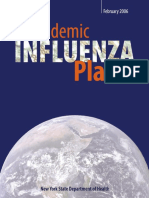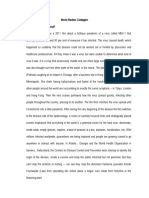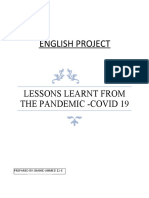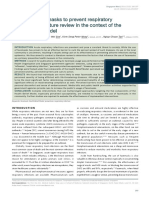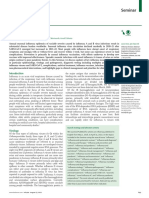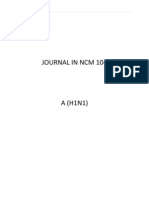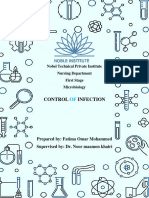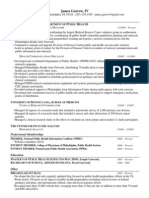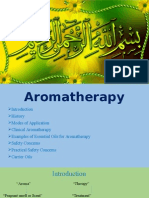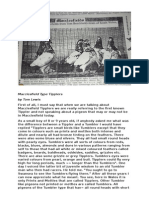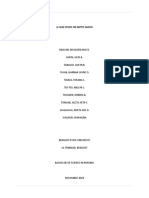Pandemic Planning: Non-Pharmaceutical Interventions
Pandemic Planning: Non-Pharmaceutical Interventions
Uploaded by
jamesgarrowCopyright:
Available Formats
Pandemic Planning: Non-Pharmaceutical Interventions
Pandemic Planning: Non-Pharmaceutical Interventions
Uploaded by
jamesgarrowOriginal Description:
Original Title
Copyright
Available Formats
Share this document
Did you find this document useful?
Is this content inappropriate?
Report this DocumentCopyright:
Available Formats
Pandemic Planning: Non-Pharmaceutical Interventions
Pandemic Planning: Non-Pharmaceutical Interventions
Uploaded by
jamesgarrowCopyright:
Available Formats
Respirology (2008) 13 (Suppl. 1), S44–S48 doi: 10.1111/j.1440-1843.2008.01258.
Pandemic planning: Non-pharmaceutical interventions
Donald E. LOW
Department of Microbiology, Mt. Sinai Hospital and the Ontario Central Public Health Laboratory,
Toronto, Ontario, Canada
Pandemic planning: Non-pharmaceutical interventions
LOW DE. Respirology 2008; 13: S44–S48
Ongoing concerns about the emergence of an influenza pandemic continue as the number of avian
and human infections with the H5N1 virus mount. Adequate amounts of vaccine or anti-virals are
unlikely to be available early on in a pandemic, and the latter could become ineffective because of
resistance. These factors have focused attention on the use of non-pharmaceutical public health
interventions to inhibit human-to-human transmission.
Key words: influenza, non-pharmaceutical interventions, pandemic.
Seasonal influenza occurs annually throughout all INTERVENTION STRATEGIES TO
areas of the world. The average person will be REDUCE IMPACT OF PANDEMIC
exposed to the influenza virus many times over the INFLUENZ A
course of his/her life and as such, will build up a
certain degree of immunity towards similar strains of Various intervention strategies reduce the impact of
the virus. This increased protection can be attained influenza on individuals and public health systems.
either through natural exposure or regular influenza In interpandemic phases, vaccination is the most
vaccinations. This acquired immunity however, will important tool to reduce morbidity and mortality, but
not help in the event of a novel or ‘pandemic’ influ- a potent vaccine will probably not be generally avail-
enza strain. able in the initial phase of a pandemic.3 Although
Pandemic influenza occurs when a new strain of anti-virals provide other potentially effective control
human influenza A emerges for which humans have strategies,4,5 not all countries can afford stockpiling
little or no pre-existing natural immunity which can enough drugs. Furthermore, concerns about the over-
spread from person to person, cause disease and is reliance of a ‘pharmaceutical solution’ have been
geographically widespread. There were three pan- expressed.6
demics during the 20th century: the Spanish Influ-
enza in 1918–19 (causing an estimated 40 million or
more deaths worldwide), the Asian Influenza in NON-PHARMACEUTICAL
1957–58 (about 1.5 million deaths worldwide) and the
INTERVENTIONS
Hong Kong Influenza in 1968–69 (about one million
deaths worldwide).1 The recent spread of highly
Since global availability of vaccine and anti-viral
pathogenic avian influenza from Asia to Europe and
agents against influenza caused by novel human
the transmission to humans has intensified concerns
subtypes are likely to be insufficient, the World
over the emergence of a novel strain of influenza with
Health Organization (WHO) recommends non-
pandemic potential. As a result, strategies are being
pharmaceutical public health interventions to
sought that will minimise the impact of the next
contain infection, delay spread and reduce the impact
pandemic.2
of pandemic disease. Aledort and colleagues7 evalu-
ated the evidence base for non-pharmaceutical
public health interventions by reviewing recent pub-
lished literature, including historical reviews, conven-
ing a meeting of experts, and formally eliciting and
quantifying expert opinion about the relative efficacy
Correspondence: Donald E. Low, Department of and effectiveness of specific non-pharmaceutical
Microbiology, Mount Sinai Hospital, 600 University interventions for pandemic influenza. They identified
Avenue, Room 1487, Toronto, ON, Canada M5G 1X5. a set of public health interventions that could poten-
Email: dLow@mtsinai.on.ca tially mitigate an influenza pandemic (Table 1).
Journal compilation © 2008 Asian Pacific Society of Respirology
No claim to original Canadian government works
Non-pharmaceutical interventions S45
Table 1 Potential non-pharmaceutical public health inter- Respiratory etiquette was also recognized as an
ventions that could mitigate an influenza pandemic important means of preventing transmission for all
patients and providers, and in the community and/or
Human surveillance home. Respiratory hygiene and cough etiquette
Case reporting included covering the mouth and nose with a tissue or
Early rapid viral diagnosis upper sleeve when coughing or sneezing, and refrain-
Disinfection ing from spitting.10
Hand hygiene
Respiratory etiquette
Surgical and N95 Masks
Other personal protective equipment 2. Human surveillance and case reporting
Patient management
Isolation of sick individuals Influenza surveillance would support a range of nec-
Provision of social support services to the isolated essary preparedness activities, including: (i) providing
Contact management information regarding the presence and epidemiol-
Quarantine ogy of influenza viruses in the community; (ii) deter-
Voluntary sheltering mining appropriate interventions; (iii) targeting
Contact tracing interventions; and (iv) generating current accurate
Community restrictions information for public health officials, providers and
School closures the public.
Workplace closures
Cancellation of group events
International and domestic travel restrictions 3. Rapid viral diagnosis
Adapted from Aledort et al.7 A rapid and sensitive test for influenza would aid in
the efficient allocation of limited resources such as
isolation facilities and anti-viral agents.
Table 2 Non-pharmaceutical public health interventions
that would most likely mitigate an influenza pandemic
4. Provider and patient use of masks and other
1. Hand hygiene and respiratory etiquette
2. Human surveillance and case reporting
personal protective equipment
3. Rapid viral diagnosis
4. Provider and patient use of masks and other personal
Uncertainty about the mode of influenza transmis-
protective equipment
sion has influenced debate about when and whether
5. Isolation of the sick
to use masks or N95 respirators for pandemic influ-
enza. Droplet transmission is thought to be the
Adapted from Aledort et al.7 primary mode of transmission, and provides the basis
for Centers for Disease Control (CDC) guidelines that
health-care personnel wear masks for close patient
contact (i.e. within 3 feet) to control influenza trans-
Unfortunately their formal ratings of the articles mission during the influenza season. But experience
revealed few high quality studies to inform the evi- from seasonal influenza also provides evidence of
dence base for non-pharmaceutical interventions. contact, droplet and droplet nuclei (aerosol) trans-
The majority of topically relevant articles identified mission of influenza that lends support for N95 respi-
were narrative reviews, case reports, observational rators, which are designed to stop more than 95% of
studies or expert opinion, editorials and commentar- small airborne particles.11,12 A recent Institute of Medi-
ies. As a result they were required to rely on expert cine study found that empirical evidence about the
opinion to determine what non-pharmaceutical efficacy or effectiveness of inexpensive, disposable
interventions were most likely to be of benefit masks and respirators against influenza is limited.13 It
(Table 2). is recognized that poor training, improper use and,
for N95 respirators, the need for fit-testing may com-
1. Hand hygiene and respiratory etiquette promise the overall effectiveness of these measures.
Hospital-based infection control measures such as
hand hygiene and respiratory etiquette to prevent the 5. Isolation of the sick
spread of infection are widely supported in the litera-
ture and broadly accepted. Many controlled studies The amount of influenza virus shed by symptomatic
have shown a protective effect of hand hygiene in individuals is greater than in the asymptomatic
reducing upper respiratory infections, although few phase, but viral shedding typically begins shortly after
of the infections studied were due to influenza.8,9 They infection and before the onset of symptoms. This
found evidence to suggest that use of an alcohol- limits the efficacy of isolation except for individuals
based hand sanitizer was more effective in preventing completely quarantined almost immediately after
the direct spread of most infections. contact with an infected person.
Journal compilation © 2008 Asian Pacific Society of Respirology
No claim to original Canadian government works
S46 DE Low
PAST EXPERIENCE WITH THE USE
OF NON-PHARMACEUTICAL
INTERVENTIONS
Most pandemic influenza policy-makers agree that
even the most rigorous non-pharmaceutical inter-
ventions are unlikely either to prevent a pandemic or
change a population’s underlying biological suscep-
tibility to the pandemic virus. However, a growing
body of theoretical modelling research suggests that
non-pharmaceutical interventions might play a role
in delaying the temporal effect of a pandemic, reduc-
ing the overall and peak attack rate, and reducing the
number of deaths.14–18 Such measures could poten-
tially provide valuable time for production and distri- Figure 1 Excess pneumonia and influenza mortality over
bution of pandemic-strain vaccine and anti-viral 1913–17 baseline in Philadelphia and St. Louis, 8 September
medication. Optimally, appropriate implementation to 28 December 1918. Reproduced with permission from
of non-pharmaceutical interventions would decrease National Academy of Sciences, USA.15,20
the burden on health care services and critical
infrastructure.
The historical record of the 1918–19 influenza pan- Markel et al.14 examined the implementation of
demic in the United States constitutes one of the non-pharmaceutical interventions for epidemic miti-
largest recorded experiences with the use of non- gation in 43 cities in the US from 8 September 1918
pharmaceutical interventions to mitigate an easily through to 22 February 1919 to determine whether
spread, high mortality and morbidity influenza virus city-to-city variation in mortality was associated
strain (i.e. a category 4–5 pandemic using the Centers with the timing, duration and combination of non-
for Disease Control and Prevention February 2007 pharmaceutical interventions. Non-pharmaceutical
Interim Pre-Pandemic Planning Guidance).19 interventions were grouped into three major catego-
The intensity of the 1918 pandemic varied widely ries: school closure, cancellation of public gatherings,
among US cities. Cities also varied widely in their and isolation and quarantine. The cities that imple-
choice and timing of implementation of non- mented non-pharmaceutical interventions earlier
pharmaceutical interventions designed to reduce had greater delays in reaching peak mortality, lower
disease spread. Many cities closed schools, churches, peak mortality rates and lower total mortality. They
theatres, dance halls or other public accommoda- also found a statistically significant association
tions; made influenza a notifiable disease; banned between increased duration of non-pharmaceutical
funerals or other public gatherings; or introduced iso- interventions and a reduced total mortality burden.
lation of sick persons. In some cases, these non- Hatchett and colleagues15 obtained data on the
pharmaceutical interventions were put in place in the timing of 19 classes of non-pharmaceutical interven-
first days of epidemic spread in a city, whereas in tions in 17 US cities during the 1918 pandemic. They
other cases, they were introduced late or not at all. found that cities in which multiple interventions were
The contrast of mortality outcomes between Phila- implemented at an early phase of the epidemic had
delphia and St. Louis is particularly striking15,20 peak death rates ~50% lower than those that did not
(Fig. 1). The first cases of disease among civilians in and had less-steep epidemic curves.
Philadelphia were reported on 17 September 1918, It was noted that non-pharmaceutical interven-
but authorities downplayed their significance and tions used in 1918 did not last indefinitely; rather,
allowed large public gatherings, notably a citywide most of the non-pharmaceutical interventions in the
parade on 28 September 1918, to continue. School study cities appear to have been relaxed within
closures, bans on public gatherings and other social 2–8 weeks, whereas opportunities for reintroduction
distancing interventions were not implemented until and transmission of the pandemic virus extended for
October 3, when disease spread had already begun to many months. Therefore, if highly effective non-
overwhelm local medical and public health resources. pharmaceutical interventions are put in place early in
In contrast, the first cases of disease among civilians the epidemic which results in a smaller epidemic,
in St. Louis were reported on 5 October, and authori- then a large proportion of the population will remain
ties moved rapidly to introduce a broad series of susceptible to the renewed spread of the virus once
measures designed to promote social distancing, interventions are relaxed. In the absence of an effec-
implementing these on 7 October. The difference in tive method of otherwise inducing immunity in the
response times between the two cities (~14 days, uninfected population (i.e. a well-matched vaccine),
when measured from the first reported cases) repre- such an epidemic is likely to have two phases, with
sents approximately three to five doubling times for the first phase mitigated by non-pharmaceutical
an influenza epidemic. The costs of this delay appear interventions and the second commencing after
to have been significant; by the time Philadelphia non-pharmaceutical interventions are relaxed.14 In
responded, it faced an epidemic considerably larger the review of 17 cities studied by Hatchett and col-
than the epidemic St. Louis faced.15 leagues,15 they observed that cities that implemented
Journal compilation © 2008 Asian Pacific Society of Respirology
No claim to original Canadian government works
Non-pharmaceutical interventions S47
non-pharmaceutical interventions sooner had lower
peak mortality rates during the first wave and were at
greater risk of a large second wave.
THE IMPLEMENTATION OF
NON-PHARMACEUTICAL MEASURES
On 1 February 2007, the US Centers for Disease
Control and Prevention19 released a guidance docu-
ment for the use of non-pharmaceutical interven-
tions during an influenza pandemic entitled ‘Interim
Pre-pandemic Planning Guidance: Community
Strategy for Pandemic Influenza Mitigation in the
United States—Early, Targeted, Layered Use of Non-
pharmaceutical Interventions’.19 Their use of non-
pharmaceutical interventions is intended to result in:
1 Delaying the exponential growth in incident case
and shifting the epidemic curve to the right in order to
‘buy time’ for production and distribution of a well-
matched pandemic strain vaccine,
2 Decreasing the epidemic peak, and
3 Reducing the total number of incident cases, thus
reducing community morbidity and mortality.
The guidance proposes a ‘tool-kit’ of four non-
pharmaceutical interventions to be used by commu- Figure 2 Pandemic Severity Index.19
nities to mitigate the effects of a pandemic:
1 Voluntary isolation of the sick at home or in a could result in unintended social and economic con-
hospital sequences. It is also recognized that more research is
2 Voluntary home quarantine of potentially exposed needed in areas such as improved surveillance
family members of the sick systems that are timely and sensitive to allow for the
3 Child social distancing, including dismissal of stu- prompt determination of the Pandemic Severity
dents from schools, closure of childcare programs Index level, rapid and reliable diagnostic tools,
and reduced out-of-school social contacts and com- the feasibility of implementation of the non-
munity mixing pharmaceutical interventions, the efficacy of the non-
4 Adult social distancing, including cancellation of pharmaceutical interventions, and the unintended
large public gatherings and alteration of work envi- social consequences of the interventions.19
ronments and schedules.
To guide the use of these interventions, the CDC CONCLUSIONS
developed a Pandemic Severity Index (Fig. 2) to cat-
egorize the severity of a pandemic, with the intent Although communities in the 1918 pandemic had
of allowing communities to consider different neither effective vaccines nor anti-virals, cities that
recommendations under different pandemic circum- were able to organize and execute a number of non-
stances. The Pandemic Severity Index uses a five- pharmaceutical interventions appeared to have an
point scale that is based on a pandemic’s case fatality associated mitigated epidemic experience. These
ratio; that is, the percentage of pandemic influenza observations suggests that non-pharmaceutical inter-
cases that die. A category 1 pandemic would have a ventions can play a critical role in mitigating the
case fatality rate of <0.1%, category 3 would have a consequences of future severe influenza pandemics
case fatality rate of 0.5–1.0%, and category 5 would be (categories 4 and 5) and should be considered for
>2.0%. Based upon the Pandemic Severity Index level inclusion in contemporary planning efforts as com-
of a pandemic, some or all of the non-pharmaceutical panion measures to developing effective vaccines and
interventions would be recommended. For example, medications for prophylaxis and treatment.
in a category 1 pandemic, only isolation of the sick
would be recommended. In a category 4 or 5 pan-
demic, all four non-pharmaceutical interventions CONFLICT OF INTEREST
would be recommended. The CDC also uses the Pan-
demic Severity Index to guide decisions about how No conflict of interest has been declared by the
long measures need to be implemented. For example, author.
for a category 2 or 3 pandemic, the CDC suggests that
measures be implemented for 4 weeks or less; for REFERENCES
category 4 or 5 pandemics, the CDC recommends that
measures be implemented for up to 12 weeks.19 1 Johnson NP, Mueller J. Updating the accounts: global
The document recognizes that use of non- mortality of the 1918–1920 ‘Spanish’ influenza pan-
pharmaceutical interventions during a pandemic demic. Bull. Hist. Med. 2002; 76: 105–15.
Journal compilation © 2008 Asian Pacific Society of Respirology
No claim to original Canadian government works
S48 DE Low
2 Mounier-Jack S, Coker RJ. How prepared is Europe for of Personal Protective Respiratory Equipment: An
pandemic influenza? Analysis of national plans. Lancet Assessment of the Evidence. 1–58. Council of Canadian
2006; 367: 1405–11. Academies, Ottawa, 2007. Influenza and Personal Pro-
3 Webby RJ, Webster RG. Are we ready for pandemic influ- tective Respiratory Equipment.
enza? Science 2003; 302: 1519–22. 13 Institute of Medicine of the National Academies, Com-
4 Longini IM Jr, Halloran ME, Nizam A, Yang Y. Containing mittee on the development of reusable facemasks for use
pandemic influenza with antiviral agents. Am. J. Epide- during an influenza. Reusability of Facemasks During an
miol. 2004; 159: 623–33. Influenza Pandemic. The National Academies Press,
5 Ferguson NM, Cummings DA, Cauchemez S, Fraser C, Washington, DC, 2006.
Riley S et al. Strategies for containing an emerging influ- 14 Markel H, Lipman HB, Navarro JA, Sloan A, Michalsen J
enza pandemic in Southeast Asia. Nature 2005; 437: 209– et al. Nonpharmaceutical interventions implemented by
14. US cities during the 1918–19 influenza pandemic. JAMA
6 Jefferson T, Demicheli V, Rivetti D, Di Jones MPC, Rivetti 2007; 298: 644–54.
A. Antivirals for influenza in healthy adults: systematic 15 Hatchett RJ, Mecher CE, Lipsitch M. Public health inter-
review. Lancet 2006; 367: 303–13. ventions and epidemic intensity during the 1918 influ-
7 Aledort JE, Lurie N, Wasserman J, Bozzette SA. Non- enza pandemic. Proc. Natl. Acad. Sci. USA 2007; 104:
pharmaceutical public health interventions for pan- 7582–7.
demic influenza: an evaluation of the evidence base. 16 Bootsma MC, Ferguson NM. The effect of public
BMC Public Health 2007; 7: 208. health measures on the 1918 influenza pandemic in
8 Sickbert-Bennett EE, Weber DJ, Gergen-Teague MF, U.S. cities. Proc. Natl. Acad. Sci. USA 2007; 104: 7588–
Sobsey MD, Samsa GP et al. Comparative efficacy of 93.
hand hygiene agents in the reduction of bacteria and 17 Bell DM. Non-pharmaceutical interventions for pan-
viruses. Am. J. Infect. Control. 2005; 33: 67–77. demic influenza, international measures. Emerg. Infect.
9 White C, Kolble R, Carlson R, Lipson N, Dolan M et al. Dis. 2006; 12: 81–7.
The effect of hand hygiene on illness rate among stu- 18 Bell DM. Non-pharmaceutical interventions for pan-
dents in University residence halls. Am. J. Infect. Control. demic influenza, national and community measures.
2003; 31: 364–70. Emerg. Infect. Dis. 2006; 12: 88–94.
10 Centers for Disease Control. Respiratory Hygiene/Cough 19 Centers for Disease Control. Interim Pre-Pandemic Plan-
Etiquette in Healthcare Settings. [Accessed 18 Jan ning Guidance: Community Strategy for Pandemic Influ-
2008.] Available from URL: http://www.cdc.gov/flu/ enza Mitigation in the United States: Early, Targeted,
professionals/infectioncontrol/resphygiene.htm Layered Use of Nonpharmaceutical Interventions.
11 Bridges CB, Kuehnert MJ, Hall CB. Transmission of influ- Centers for Disease Control and Prevention, Atlanta, GA,
enza: implications for control in health care settings. 2007.
Clin. Infect. Dis. 2003; 37: 1094–101. 20 Sattenspiel L, Herring DA. Simulating the effect of quar-
12 Low DE, Bartlett K, Baudouin J-L, Bourgault AM, antine on the spread of the 1918–19 flu in central
Brosseau L et al. Influenza Transmission and the Role Canada. Bull. Math. Biol. 2003; 65: 1–26.
Journal compilation © 2008 Asian Pacific Society of Respirology
No claim to original Canadian government works
You might also like
- Nonpharmaceutical Interventions For Pandemic Influenza, International MeasuresDocument7 pagesNonpharmaceutical Interventions For Pandemic Influenza, International MeasuresjamesgarrowNo ratings yet
- How To Improve Influenza Vaccine Coverage of Healthcare PersonnelDocument5 pagesHow To Improve Influenza Vaccine Coverage of Healthcare PersonnelOren KatzNo ratings yet
- WHO Strategic Action Plan For Pandemic InfluenzaDocument22 pagesWHO Strategic Action Plan For Pandemic InfluenzaTarequr RahmanNo ratings yet
- Disease Mitigation Measures in The Control of Pandemic InfluenzaDocument10 pagesDisease Mitigation Measures in The Control of Pandemic InfluenzaZerohedge100% (1)
- 202 8 1154 PDFDocument7 pages202 8 1154 PDFSiti Zamilatul AzkiyahNo ratings yet
- Pandemic Influenza PlanDocument406 pagesPandemic Influenza PlanarquivoslivrosNo ratings yet
- CH#01Document4 pagesCH#01Emran khanNo ratings yet
- WHO 2019 Ncov IPC - Masks 2020.3 EngDocument5 pagesWHO 2019 Ncov IPC - Masks 2020.3 EngStephanie SommerfeldNo ratings yet
- Vaccination of Healthcare Workers A ReviewDocument17 pagesVaccination of Healthcare Workers A Reviewy2h996tnp8No ratings yet
- Report On Pandemic InfluenzaDocument32 pagesReport On Pandemic InfluenzaFhan Sani SeowNo ratings yet
- 2021 Lancet Community-Acquired PneumoniaDocument14 pages2021 Lancet Community-Acquired PneumoniaCarlos Del Valle JaureguiNo ratings yet
- A (H1N1)Document3 pagesA (H1N1)vincesumergidoNo ratings yet
- 14 Petit LongoDocument17 pages14 Petit LongobaliardoforcaNo ratings yet
- Whooping Cough Unveiled: From Pathogenesis to Promising TherapiesFrom EverandWhooping Cough Unveiled: From Pathogenesis to Promising TherapiesNo ratings yet
- EBP Chikv PaperDocument22 pagesEBP Chikv PaperMiserable*No ratings yet
- Contagion (Movie Review)Document5 pagesContagion (Movie Review)Stephy SalvadorNo ratings yet
- Smallpox Binder Chapter.2008.FINAL Id314Document14 pagesSmallpox Binder Chapter.2008.FINAL Id314subhadipbhunia.studentNo ratings yet
- Communicable Disease Surveillance: OfepidemiologyDocument4 pagesCommunicable Disease Surveillance: OfepidemiologyMuhammad Hafiidh MuizzNo ratings yet
- APhA Immunization Module 3Document49 pagesAPhA Immunization Module 3Gerald GamboaNo ratings yet
- Understanding The Risk of An Avian Flu Pandemic: Rational Waiting or Precautionary Failure?Document15 pagesUnderstanding The Risk of An Avian Flu Pandemic: Rational Waiting or Precautionary Failure?jen610iNo ratings yet
- Canvasmodic HistoryDocument4 pagesCanvasmodic HistoryFRANCESCA MAE P. DELAS PEÑASNo ratings yet
- WHO Masks GuidelinesDocument5 pagesWHO Masks GuidelinesLarryDCurtisNo ratings yet
- Pandemic Flu - Lessons From The Front LinesDocument24 pagesPandemic Flu - Lessons From The Front Linescstack3No ratings yet
- Pandemic Module - Outbreak ManagementDocument16 pagesPandemic Module - Outbreak Managementdr.sarathkumar321No ratings yet
- Influenza Vaccination Among Infection Control Teams A EUCIC Surve - 2020 - VaccDocument5 pagesInfluenza Vaccination Among Infection Control Teams A EUCIC Surve - 2020 - VaccSavaNo ratings yet
- English ProjectDocument18 pagesEnglish ProjectSHADOW BOYNo ratings yet
- Knowledge, and Practice Towards Infection Control Measures For The Novel Corona Virus Among Nurses Working at Isolation DepartmentDocument49 pagesKnowledge, and Practice Towards Infection Control Measures For The Novel Corona Virus Among Nurses Working at Isolation DepartmentOmima MuhammedNo ratings yet
- 9 - Outbreak Management Surveillance System Spring 2024Document20 pages9 - Outbreak Management Surveillance System Spring 2024dymoha1234No ratings yet
- Ciy 866Document47 pagesCiy 866Skripsi ulmNo ratings yet
- Against InfluenzaDocument13 pagesAgainst InfluenzamariavillaresNo ratings yet
- Jamaophthalmology Sommer 2020 Ic 200013 PDFDocument2 pagesJamaophthalmology Sommer 2020 Ic 200013 PDFfaisaladeNo ratings yet
- Virus Influenza Guidlines PDFDocument47 pagesVirus Influenza Guidlines PDFМарија СерафимовскаNo ratings yet
- HES-032-BSN-Lab-Activity-9Document8 pagesHES-032-BSN-Lab-Activity-9Glorelie Arnoco - ABM 3No ratings yet
- Precious Marie Dipus - Synthesis PaperDocument5 pagesPrecious Marie Dipus - Synthesis PaperPreciousNo ratings yet
- Pandemic of COVID-19Document25 pagesPandemic of COVID-19Arpita MohapatraNo ratings yet
- Nos InfecDocument6 pagesNos InfecMimi ElagoriNo ratings yet
- Makalah AirborneDocument9 pagesMakalah AirborneHeru SigitNo ratings yet
- Comment: The Lancet Provide Some of This Information: The StudyDocument2 pagesComment: The Lancet Provide Some of This Information: The StudyWiliam Silva CarrilloNo ratings yet
- Review of Related Literature: COVID-19Document17 pagesReview of Related Literature: COVID-19Ed Anthony YubacNo ratings yet
- Chapter 6 - Protecting Human HealthDocument37 pagesChapter 6 - Protecting Human HealthlosangelesNo ratings yet
- The Use of Facemasks To Prevent Respiratory Infection: A Literature Review in The Context of The Health Belief ModelDocument8 pagesThe Use of Facemasks To Prevent Respiratory Infection: A Literature Review in The Context of The Health Belief ModelmedicembuNo ratings yet
- PIIS0140673622009825Document14 pagesPIIS0140673622009825mauriciosagredoNo ratings yet
- Facemasks and Hand Hygiene To Prevent Influenza TR PDFDocument21 pagesFacemasks and Hand Hygiene To Prevent Influenza TR PDFTiudusNo ratings yet
- Risco de Infecção Respiratória em Profissionais Da SaúdeDocument7 pagesRisco de Infecção Respiratória em Profissionais Da SaúdeEduardo SallesNo ratings yet
- Final Requirement (FINAL EXAM)Document4 pagesFinal Requirement (FINAL EXAM)KATHLEEN JOSOLNo ratings yet
- Mass Gatherings Evidence ReviewDocument72 pagesMass Gatherings Evidence ReviewRogueNo ratings yet
- Masks Don't WorkDocument9 pagesMasks Don't WorkKaVONo ratings yet
- Nonpharmaceutical Measures For Pandemic Influenza in Nonhealthcare Settings-Personal Protective and Environmental MeasuresDocument36 pagesNonpharmaceutical Measures For Pandemic Influenza in Nonhealthcare Settings-Personal Protective and Environmental MeasuresNothingToSeeHereNo ratings yet
- Infection Prevention in The Health Care SettingDocument11 pagesInfection Prevention in The Health Care SettingMARIA SOL MONTALVO LALALEONo ratings yet
- Journal in NCM 104Document14 pagesJournal in NCM 104Chet LlanesNo ratings yet
- Developing Pandemic Communication Strategies 'Preparation Without Panic'Document7 pagesDeveloping Pandemic Communication Strategies 'Preparation Without Panic'JeiNo ratings yet
- Andre FE (2008) - Vaccination Greatly Reduces Disease, Disability, Death and Inequity Worldwide PDFDocument7 pagesAndre FE (2008) - Vaccination Greatly Reduces Disease, Disability, Death and Inequity Worldwide PDFHoa NắngNo ratings yet
- Infection Control in NICUDocument9 pagesInfection Control in NICUMike CalipayanNo ratings yet
- COVID-19 Testing: A Reflection On Test Accuracy in The Real WorldDocument34 pagesCOVID-19 Testing: A Reflection On Test Accuracy in The Real Worldjoeboots78No ratings yet
- Ten Warning Signs of Primary Immunodeficiency: A New Paradigm Is Needed For The 21st CenturyDocument8 pagesTen Warning Signs of Primary Immunodeficiency: A New Paradigm Is Needed For The 21st CenturyVette Angelikka Dela CruzNo ratings yet
- Chelsey (Chapter 2 RRL) LocalDocument3 pagesChelsey (Chapter 2 RRL) LocalChester ArenasNo ratings yet
- Khvi 11 11 1096457Document10 pagesKhvi 11 11 1096457The UmarNo ratings yet
- Outbreak Investigations-A PerspectiveDocument7 pagesOutbreak Investigations-A Perspectivebwchamp1No ratings yet
- MICROBIOLOGYDocument9 pagesMICROBIOLOGYAmr Ramazan IbrahimNo ratings yet
- Influenza vaccination: What does the scientific proof say?: Could it be more harmful than useful to vaccinate indiscriminately elderly people, pregnant women, children and health workers?From EverandInfluenza vaccination: What does the scientific proof say?: Could it be more harmful than useful to vaccinate indiscriminately elderly people, pregnant women, children and health workers?No ratings yet
- JIC Model 011110Document154 pagesJIC Model 011110jamesgarrowNo ratings yet
- Garrow Resume Feb10Document1 pageGarrow Resume Feb10jamesgarrowNo ratings yet
- Reducing Absenteeism in Elementary School StudentsDocument10 pagesReducing Absenteeism in Elementary School Studentsjamesgarrow100% (2)
- Prevention Control of InfluenzaDocument60 pagesPrevention Control of Influenzajamesgarrow100% (2)
- Influenza Activity - United States and Worldwide, 2007-08 SeasonDocument7 pagesInfluenza Activity - United States and Worldwide, 2007-08 SeasonjamesgarrowNo ratings yet
- CH8 Sacred Sex, Virgin and Wedding NightDocument14 pagesCH8 Sacred Sex, Virgin and Wedding NightTheVeiledGarden50% (2)
- AromatherapyDocument19 pagesAromatherapyMuhammad Mustafa Ijaz100% (1)
- It's True! Frogs Are CannibalsDocument97 pagesIt's True! Frogs Are Cannibals廖文昌No ratings yet
- FDA GuidenceDocument39 pagesFDA GuidenceChristina GrossNo ratings yet
- Dengue Fever TeksDocument3 pagesDengue Fever TeksHmpsik Stikes Muhammadiyah PalembangNo ratings yet
- Animal Enrichment Year 7 Integrated Learning TaskDocument7 pagesAnimal Enrichment Year 7 Integrated Learning Taskapi-350319898No ratings yet
- Macclesfield Type Tipplers - All You Ever Wanted To Know AboutDocument4 pagesMacclesfield Type Tipplers - All You Ever Wanted To Know AboutDavidStrossmayerNo ratings yet
- CREST English KG Workbook FinalDocument101 pagesCREST English KG Workbook FinalDr Rupali SatavalekarNo ratings yet
- CDC - Gov AngiostrongyliasisDocument2 pagesCDC - Gov AngiostrongyliasisjohndeereNo ratings yet
- ScienceSLM G10 Q3 M3 the-Nervous-System - Docx-1Document31 pagesScienceSLM G10 Q3 M3 the-Nervous-System - Docx-1John100% (1)
- Abstrak: Jurnal Kebidanan Vol. 2 No. 5 Oktober 2013 Issn.2089-7669Document11 pagesAbstrak: Jurnal Kebidanan Vol. 2 No. 5 Oktober 2013 Issn.2089-7669Nenci HaryadiNo ratings yet
- Books ButterflyDocument4 pagesBooks Butterflyapi-259262734No ratings yet
- A Case Study On Septic ShockDocument51 pagesA Case Study On Septic ShockKeThSantibanNo ratings yet
- HahahahahaDocument7 pagesHahahahahaapi-294452789No ratings yet
- 1º Ano (1º Bimestre)Document18 pages1º Ano (1º Bimestre)nataliamartinsoliveira3No ratings yet
- Working With "Rip Van Winkle": WorksheetDocument5 pagesWorking With "Rip Van Winkle": WorksheetOSRAMANo ratings yet
- NitrofurantoinDocument9 pagesNitrofurantoinIoana AntonesiNo ratings yet
- Uzair KhiljiDocument9 pagesUzair KhiljitanvirNo ratings yet
- Detailed Lesson Plan in English 6Document9 pagesDetailed Lesson Plan in English 6marelyn.no001No ratings yet
- Fcs Lesson 32 Beef BasicsDocument11 pagesFcs Lesson 32 Beef BasicsJoie M. GunosNo ratings yet
- A Detailed Lesson Plan in Science 5Document9 pagesA Detailed Lesson Plan in Science 5Mark Jayvee EstebanNo ratings yet
- The Colosseum / Flavian AmphitheatreDocument2 pagesThe Colosseum / Flavian AmphitheatreAmy JonesNo ratings yet
- Lrdi 100 PDFDocument101 pagesLrdi 100 PDFPuneet MalhotraNo ratings yet
- KoBa Set Menu-2Document4 pagesKoBa Set Menu-2Martha AcevedoNo ratings yet
- Full Registration Warranty and Sales Contract For PuppyDocument2 pagesFull Registration Warranty and Sales Contract For PuppyRotiseria La FlammeNo ratings yet
- Male Multiple Orgasm SurveyDocument3 pagesMale Multiple Orgasm SurveygmeadesNo ratings yet
- Aesops Fables The Hunter and The WoodmanDocument1 pageAesops Fables The Hunter and The WoodmanRabeel AfzalNo ratings yet
- Cot-Dlp School: Grade: Teacher: Learning Areas: Date: APRIL 4, 2022 Quarter: 2 Checked By: LINO D. LATAWAN - Principal IIDocument4 pagesCot-Dlp School: Grade: Teacher: Learning Areas: Date: APRIL 4, 2022 Quarter: 2 Checked By: LINO D. LATAWAN - Principal IIBernardoNo ratings yet
- CP Bangladesh Company Limited Rating Report 2012 CheckedDocument3 pagesCP Bangladesh Company Limited Rating Report 2012 CheckedMuannis MahmoodNo ratings yet
- Prosthetic Gait DeviationsDocument24 pagesProsthetic Gait DeviationsSubhranshu MishraNo ratings yet





